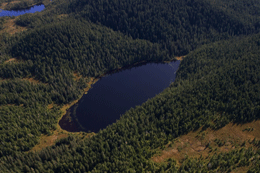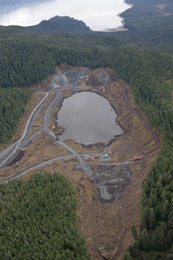A New Take on Clean Water
Air Date: Week of June 26, 2009

Acid drains from rock near Lower Slate Lake at the Kensington Mine. (Courtesy Of U.S. Forest Service)
A recent 6 to 3 vote in the Supreme Court, ruled that fill material from mines will no longer count as pollution. In accordance, toxic tailings from mines can now be deposited directly into our waterways. Such dumping is set to happen at the Kensington gold mine in Lower Slate Lake in Alaska, not to mention into other waterways throughout the U.S. The ball is now in the Obama administration’s court— they can allow this dumping or revert back to a definition of fill material that fits the original intent of the Clean Water Act. Host Steve Curwood talks with the environmental lawyer, Tom Waldo, who argued this case before the Supreme Court.
Transcript
CURWOOD: From the Jennifer and Ted Stanley studios in Somerville, Massachusetts, this is Living on Earth. I’m Steve Curwood.
Lead, mercury, caustic chemicals. These poisons make up part of the slurry from gold mining. Now, by 6-3 vote, the US Supreme Court has upheld a permit that allows a mine operation to dump its toxic tailings into the Lower Slate Lake in Alaska’s wilderness.
At the same time the high court said the Obama administration is free to revoke the permit, which was issued under rules adopted by the Bush administration. Tom Waldo is a lawyer for EarthJustice who argued against the mine at the Supreme Court.
Hi, Tom.
WALDO: Hi, Steve.
CURWOOD: Tom, before we ask you about the details of the case, what’s special about Lower Slate Lake?

Lower Slate Lake in 2005, before mining operations. (Photo: Pat Costello)
CURWOOD: What exactly did the Supreme Court decide in this case? They ruled against you. They said “hey, the Bush administration ticked all the boxes that were necessary to issue a permit for the mine to put its leavings in the lake, describing them as fill. What was really decided in this case?
WALDO: Well, the Supreme Court upheld a permit issued by the Army Corps of Engineers that authorized the mining company to discharge 200,000 gallons per day of toxic wastewater pollution from a gold ore processing mill. The effect of the discharge would be to kill all of the fish and other aquatic life in the lake and over the ten-year life of the mine, the discharge would deposit four-and-a-half million tons of solids into the lake. And the Corps of Engineers did this even though EPA has had rules in place since 1975 that prohibit this exact kind of discharge.

Lower Slate Lake in 2006, after the surrounding trees were cut down and access roads built. (Photo: Pat Costello, Courtesy of Lighthawk)
WALDO: They did it by a ruse. They redefined the pollution as fill material. Now fill material is usually understood to be sand or gravel or rocks that are deposited in water for some useful purpose, like to build a levee or a sea wall or a bridge or made a building on wetlands. What they did during the Bush administration was they redefined fill material much more broadly so that it would encompass even pollution from industrial manufacturing facilities if it contains a lot of solids that could deposit on the bottom of a water body. That’s what they did here, and that’s what the Supreme Court upheld.
CURWOOD: How consistent was this ruling with the intent of the Clean Water Act, do you think?
WALDO: It’s not consistent at all. The intent of the Clean Water Act is to make waters fishable, swim-able, and drinkable again. The purpose of the act was to stop the practice of using lakes and rivers and streams as industrial waste dumps, but that’s exactly what the Army Corps of Engineers authorized here. They authorized the mining company to use Lower Slate Lake as a waste dump. It’s entirely contrary to the purposes of the Clean Water Act, and there’s just a crying need for Congress and the administration to act to correct this problem.
CURWOOD: The mine deposits from Kensington could raise the lakebed there some fifty feet and eventually triple the lake size to sixty acres. How would this raise in water level change the lake’s ecosystem?
WALDO: Well, it would change it into a much larger and shallower lake. The entire bottom of the lake would be filled up with mine tailings. When they were going through the process of preparing these permits, they tested some sample mine tailings to see what effect they would have on the fresh water life that lives in the lake and found that it was highly toxic. So, it will be a long and difficult process for this lake ever to recover if it is ever possible.

Acid drains from rock near Lower Slate Lake at the Kensington Mine. (Courtesy Of U.S. Forest Service)
CURWOOD: You’ve lost in the Supreme Court, but you say the fight’s not over.
WALDO: Oh yeah. Like I said, we’re continuing to ask the Obama administration to fix the problem underlying this case through new regulations defining fill material. We would like Congress to act on the Clean Water Protection Act. And in the meantime the administration has the authority to rescind the Kensington Mine permit. EPA can veto that permit under its rules and the Corps of Engineers can rescind that permit under its rules, and we hope the administration will do that.
CURWOOD: Tom Waldo is a lawyer for Earthjustice. Thank you so much.
WALDO: It’s a pleasure.
Links
Living on Earth wants to hear from you!
Living on Earth
62 Calef Highway, Suite 212
Lee, NH 03861
Telephone: 617-287-4121
E-mail: comments@loe.org
Newsletter [Click here]
Donate to Living on Earth!
Living on Earth is an independent media program and relies entirely on contributions from listeners and institutions supporting public service. Please donate now to preserve an independent environmental voice.
NewsletterLiving on Earth offers a weekly delivery of the show's rundown to your mailbox. Sign up for our newsletter today!
 Sailors For The Sea: Be the change you want to sea.
Sailors For The Sea: Be the change you want to sea.
 The Grantham Foundation for the Protection of the Environment: Committed to protecting and improving the health of the global environment.
The Grantham Foundation for the Protection of the Environment: Committed to protecting and improving the health of the global environment.
 Contribute to Living on Earth and receive, as our gift to you, an archival print of one of Mark Seth Lender's extraordinary wildlife photographs. Follow the link to see Mark's current collection of photographs.
Contribute to Living on Earth and receive, as our gift to you, an archival print of one of Mark Seth Lender's extraordinary wildlife photographs. Follow the link to see Mark's current collection of photographs.
 Buy a signed copy of Mark Seth Lender's book Smeagull the Seagull & support Living on Earth
Buy a signed copy of Mark Seth Lender's book Smeagull the Seagull & support Living on Earth

